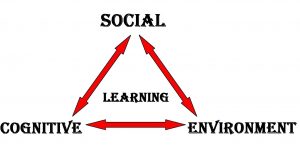By Gaby Dufresne-Cyr, Owner and Founder of the Dogue Shop
What is social learning in dogs, and why bother with social cognitive learning theory (SCT)? Here is a look at a theory which is rapidly changing dog training, but more specifically, dog behavior modification. The topic is complex; therefore, allow me to break it down into a few sections.
What is social cognitive learning theory?
Social cognitive learning is an extension of Albert Bandura’s social learning theory developed in the 1960s. One definition for social learning is reciprocal determinism based on social influences developed during attachment. The social bond directly influences imitation. In the SCT the attachment style is the most important aspect of learning.
Bandura concluded his observations after he conducted an experiment we now refer to as the bobo doll. Researchers exposed children to aggressive behaviors exhibited by adults towards toys. Researchers found children who observed adults inflicting aggressive behaviors to toys were more likely to replicate the aggression than children exposed to passive behavior. Furthermore, the attachment of the child towards the adult yielded more aggressive behaviors than observations from strangers.
Bandura explained the model with the use of a triangle. Each part of the triangle is bi-directional and must be present for learning to occur. Break one direction and learning ceases. The theory states a secure attachment between individual subjects allows for learning to take place when placed in a favorable environment; therefore, if all three components are present, learning takes place. The revolutionary process has to do with cognition. Problem solving links to attachment to problem solving because it creates a trusting association between the two individuals.

A secure attachment, in turn, allows the cognitive process to flourish. However, if the environment is stressful, distracting, or uncomfortable: too hot, too cold, noisy, smelly, cluttered, too small, too big, etc. learning will be very difficult, not to say impossible. Another important factor influences learning: the individuals involved. Both parties within the triangle need to be predisposed to learning. The biological environment we call the body is directly responsible to successes or failures. If you need to urinate, you will not teach or learn. If a dog needs to urinate, we obtain the same result. Below are the necessary components for social cognitive learning to occur.
- Human
- Biology
- Cognition
- Dog
- Biology
- Cognition
- Attachment
- Secure
- Environment
- Climate
- Size
- Sensory
Although some components can change over time, others will remain the same. Behaviorism remains essential and we will not replace one theory with another. I propose you add it to your tool box.
Why bother with social cognitive theory?
Social cognitive learning is not only fun, it saves training time, effort, emotional disturbances, and cost. It prevents stress, confusion, emotional overload, and weight problems associated with overfeeding treats. It also reduces aggression and eliminates punishment and the use of aversive tools such as chokes, prongs, electric shock, or e-collars. Any method can be made abusive and inadequate, but social learning breaks the rule.
A person cannot create a triangle from pokes and kicks. Problem solving will not occur if electric shocks or “vibrations” are administered to animals. In my experience, the social cognitive learning model prevents and eliminates abuse. Extreme positive reinforcement only and punishment based trainers cannot establish a relationship if one of the pieces of the triangle is missing or if one direction is not functional.
Another reason to hop-on the social cognitive learning bandwaggon is the effectiveness and speed at which behavior modification occurs. Here is an example: you want to train a service dog to accomplish the open drawer behavior. With behaviorism’s classical and operant conditioning, it would take month, if not years, to shape the behavior. If we apply SCT learning to the training process, we can train complex behavior chains in a matter of minutes. I do not know about you, but to me, that is amazing and practical when dogs needed to know their behaviors, say, yesterday.
Furthermore, SCT learning facilitates behavior modification because it addresses problems at their source: emotions. Behaviorism works toward behavior changes, positive or negative. Social cognitive learning changes emotions at their fundamental core; consequently, SCT is an excellent addition to your toolbox. I know, I am repeating myself, but the process is so amazing. Imagine dogs that not only learn; imagine dogs that have learned how to learn; consequently, they offer you behaviors you have just demonstrated.
Conclusion
Social cognitive learning theory will not replace behaviorism – it will complement it. Our responsibility towards animals is to train them in the least amount of time, limit financial strain, and lessen emotional disturbance as much as possible. When we can, our role is to utilize all the knowledge available to us. I believe, as an animal professional, attachment and imitation can help us train and modify behavior without lengthy protocols or emotional disturbance, so why turn a blind eye?
***
About the Author:
 Gaby Dufresne-Cyr, Owner and Founder of the Dogue Shop, has been training animals professionally for over 30 years. She offers innovative training programs, workshops, conferences, and seminars which will undoubtedly challenge your dog knowledge. Gaby works with a wide variety of species but concentrates on canidae (wolves, coyotes, and dogs), equidae (zebras, horses, mules, and donkeys), and muriadae (rats and mice). Her favorite animal to train is the giraffe. Gaby spends most of her time bettering the animal community however she can. Her perspective on life is to never think within the box, for the box limits you.
Gaby Dufresne-Cyr, Owner and Founder of the Dogue Shop, has been training animals professionally for over 30 years. She offers innovative training programs, workshops, conferences, and seminars which will undoubtedly challenge your dog knowledge. Gaby works with a wide variety of species but concentrates on canidae (wolves, coyotes, and dogs), equidae (zebras, horses, mules, and donkeys), and muriadae (rats and mice). Her favorite animal to train is the giraffe. Gaby spends most of her time bettering the animal community however she can. Her perspective on life is to never think within the box, for the box limits you.
Additional Links:

